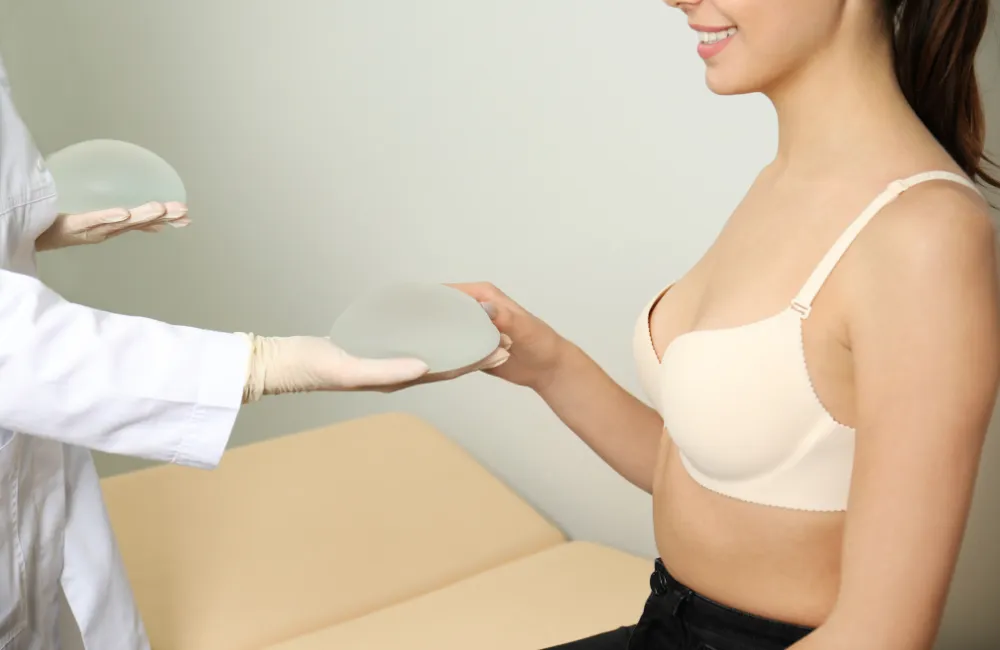Signs It’s Time for a Breast Implant Replacement and What to Expect
By Partington Plastic Surgery on February 15, 2024 in Breast Implants

Like any medical device, breast implants are not lifetime guaranteed. Aging, lifestyle changes, and implant wear and tear may require replacement. Maintaining both health and aesthetic satisfaction depends on knowing the warning signals that point to a breast implant replacement is recommended. The following article will highlight these symptoms and prepare you for breast surgery by explaining what to expect.
Common Reasons for the Replacement of Breast Implants
Breast implant rupture, which can cause changes in breast form and firmness, is one of the main causes breast implants may need replacement.
Capsular contracture, in which tight breast tissue forms around the implant and causes discomfort and changes the look of the breast, is another reason for replacement. Natural aging, weight changes, and personal preferences are additional factors. Knowing these factors will enable one to make wise choices about breast implant replacement surgery.
Patients’ short- and long-term outcomes depend on their initial breast augmentation surgery. A well-executed operation reduces the chances of complications including infection, changes in breast shape, or incorrect implant placement, so promoting a faster and more comfortable recovery time. Accurate initial surgery and implant selection based on the patient’s anatomy and aesthetic goals can improve satisfaction and prevent the need for early replacement or correction treatments.
Key Signs When It’s Time for a Replacement
Capsular Contracture
The scar tissue around a breast implant thickens and constricts it, causing capsular contracture. This disorder can cause discomfort, changes in breast appearance, and a sensation of hardness or rigidity around the implant.

Based on contracture severity, non-surgical treatments like massage or medicine may be combined with surgical ones like capsulotomy or implant replacement. Knowing the possibility of capsular contraction and its symptoms will enable people to participate in proactive conversations with their doctors and make wise decisions regarding their breast implant removal and replacement recovery.
Rupture or Deflation
Silicone implants might experience “silent rupture.” Symptoms may vary with time from stiffening to changes in breast form, or pain. These implants require regular breast implant revision and tests like MRI or ultrasound to detect these potential problems early. Understanding the variations in how rupture and deflation show depending on the kind of implant helps you respond quickly to preserve breast look and integrity.
Changes in Implant Position
Implant displacement may indicate the need for breast implant replacement surgery. Breast implants may change with time depending on gravity, the natural aging process, physical injuries, or other factors that would affect breast symmetry. The implant can bottom out, rise, or move to the side, causing an unnatural appearance or discomfort. Significant weight changes, strenuous activity, or insufficient tissue support could all influence implant position alterations. These alterations may require surgery to reposition or replace implants to restore aesthetics, so it’s important to see a doctor. Early identification and treatment made possible by regular monitoring and follow-ups with your healthcare professional will help to preserve cosmetic pleasure and comfort over time.
Rippling or Wrinkling
Breast implants can ripple or wrinkle when their surface is visible or perceptible through the skin. They can damage silicone implants, especially when positioned above the muscle with inadequate covering tissue. Breast tissue loss, thin skin, and implants too large for the breast envelope can cause this problem.

Ripples or wrinkles can look different; some people may notice insignificant anomalies while others may feel more distinct textures. This condition can be more noticeable when bending over or in particular positions.
Pain or Discomfort
One important indication that a breast implant removal and replacement might be required is breast area pain or discomfort. Implant problems include capsular contracture, infection, and rupture can cause similar symptoms. Changes in implant location might potentially cause pain since they might put pressure or tension on nearby tissues. Implant-related breast pain must be differentiated from cysts, hormonal changes, and muscular tension. Patients with chronic pain should see a doctor to determine the reason. Employing a comprehensive assessment comprising imaging tests and physical examination, one can determine whether the implants cause pain.
Desire for an Updated Look
Many people’s choice to seek breast implant replacement is motivated in great part by their need for an updated appearance. Individual tastes in breast size, shape, or feel may change with time as personal aesthetics and trends do. This ambition may be to raise or decrease implant size or to produce a more natural contour that matches personal style or body image aspirations.
What to Expect During the Replacement Process
During the session, patients must communicate their aesthetic goals and talk about any developments in implant technology that appeal to them. The surgeon will explain the various implant kinds, sizes, and shapes and help the patient choose the best one for their needs and health.
Natural Look
Confident Beauty
24 Hour Rapid Recovery, Muscle Sparing.

Surgical Procedure
The surgical technique for breast implant replacement guarantees the greatest possible aesthetic and health results while also attending to the particular demands and concerns of the patient. Board-certified plastic surgeons arrange and perform the surgery under general anesthesia. The incision site is chosen, using the natural scars if possible to minimize scarring. The surgeon will gently remove breast implants once the incision is done. If an implant ruptures or leaks, the surrounding tissue will be meticulously cleansed to remove silicone. Following removal, the new implants are placed in the pocket, which can be modified depending on the desired outcome and whether the implants will be positioned above or below the chest muscle.
Recovery Time and Process
Individual health, operation complexity, and postoperative care instructions affect recovery from breast implants. Most patients should anticipate an initial recovery period of one to two weeks during which they may have edema, bruising, and surgery area discomfort. Breast implant removal and replacement recovery require regular surgeon visits.

These check-ins give chances to track healing, handle any issues or difficulties, and change treatment plans as necessary.
Tips for Breast Implant Recovery:
- Prioritize Rest;
- Manage Pain and Discomfort;
- Stay Hydrated and Eat Well;
- Avoid Smoking and Alcohol;
- Gradually Increase Activity;
- Keep Incision Sites Clean;
- Attend Follow-Up Appointments.
Communicate with doctors about odd symptoms such as increased swelling, redness, or fever, which may indicate problems. A better recovery and support to guarantee the intended breast implant revision surgery results depend on patience and following medical recommendations.
Finding a knowledgeable plastic surgeon in your area is essential for getting individualized treatment and obtaining the intended outcomes when thinking about breast implant replacement near me. Start by researching board-certified plastic surgeons with extensive experience in breast implant procedures.
Conclusion
Implant replacement is a personal, emotional, and physical decision. From selecting a qualified surgeon to carefully managing aftercare, the advice given points to a whole strategy toward guaranteeing an excellent recovery. Understanding implant alternatives and conveying aesthetic goals are crucial to accomplishing goals. Not less crucial is the dedication to follow pre- and post-operative instructions, which greatly affects the healing process and outcomes. While self-improvement is empowering, surgery risks must be considered. Comprehensive conversations with an expert will highlight possible issues and help to shape a reasonable expectation of breast implant replacement outcomes. Regular follow-up visits and monitoring for unexpected symptoms are essential for health and satisfaction.
Our clinic is committed to providing you with excellent treatment and direction during breast augmentation operations. Our board-certified plastic surgeons are available to answer inquiries and resolve worries. Our first concerns are your health and happiness; we are here to help you at every stage of improving your life!
Return to Overview